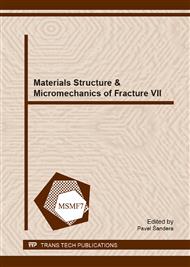p.67
p.71
p.75
p.79
p.83
p.87
p.92
p.96
p.100
Modeling and Experimental Study of Long Term Creep Damage in Austenitic Stainless Steels
Abstract:
Austenitic Stainless Steels (SSs) are presently being investigated as appropriate candidates for structural components for the future Generation IV nuclear reactors. Austenitic SSs of different grades will operate at high temperature and suffer low stress loading for decades. At the laboratory, austenitic SSs have been subjected to creep tests at various stresses and temperatures between 500°C to 700°C, up to nearly 50·103h. Interrupted creep tests show an acceleration of the reduction in cross-section only during the last 15% of creep lifetime which may be called macroscopic necking. The modeling of necking using a modified Norton power-law allows lifetime predictions in agreement with experimental data up to a few thousand hours only. And the experimental results show that, the extrapolation of the 'stress lifetime curves obtained at high stress leads to large overestimations of lifetimes at low stress. After FEGSEM observations, these overestimates are mainly due to additional intergranular cavitation along grain boundaries. The modeling of cavity growth by vacancy diffusion along grain boundaries coupled with continuous nucleation proposed by Riedel has been carried out. Lifetimes for long term creep are rather correctly predicted with respect to experimental lifetimes. The lifetime curves predicted by either the necking model or the creep cavity one cross each other, defining transition times of five to ten thousand hours for temperatures between 600°C and 700°C, in agreement with experimental curves.
Info:
Periodical:
Pages:
83-86
Citation:
Online since:
November 2013
Authors:
Price:
Сopyright:
© 2014 Trans Tech Publications Ltd. All Rights Reserved
Share:
Citation:


